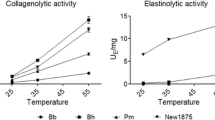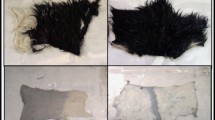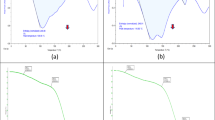Abstract
Dehairing of crude leather is a critical stage performed at the beginning of its processing to obtain industrially useful pieces. Tanneries traditionally apply a chemical process based on sodium sulfide. Since this chemical reactive is environmentally toxic and inefficiently recycled, innovative protocols for reducing or eliminating its use in leather depilation are welcomed. Therefore, latex peptidases from Calotropis procera (CpLP) and Cryptostegia grandiflora (CgLP) were assayed for this purpose. Enzyme activity on substrates representative of skin such as hide powder azure (UHPA), elastin (UE), azocollagen (UAZOCOL), keratin (UK), and epidermis (UEP) was determined, while depilation activity was assayed on cow hide. Only CpLP was active against keratin (13.4 UK) and only CgLP was active against elastin (0.12 UE). CpLP (93.0 UHPA, 403.6 UAZOCOL, 36.3 UEP) showed higher activity against the other substrates than CgLP (47.6 UHPA, 261.5 UAZOCOL, 8.5 UEP). In pilot assays, CpLP (0.05% w/v with sodium sulfite 0.6% w/v as activator) released hairs from cow hide pieces. Macroscopic and microscopic analyses of the hide revealed that the dehairing process was complete and the leather structure was preserved. The proteolytic system of C. procera is a suitable bioresources to be exploited by tanneries.





Similar content being viewed by others
References
Durga J, Ranjithkumar A, Ramesh R, Girivasan KTPV, Rose C, Muralidharan C (2015) Replacement of lime with carbohydrases—a successful cleaner process for leather making. J Clean Prod 112:1122–1127
Bhavan S, Rao JR, Nair BU (2008) A potential new commercial method for processing leather to reduce environmental impact. Environ Sci Pollut Res 15:293–295
Dixit S, Yadav A, Dwivedi PD, Das M (2015) Toxic hazards of leather industry and technologies to combat threat: a review. J Clean Prod 87:39–49
Castilho LR, Medronho RA, Alves TLM (2000) Production and extraction of pectinases obtained by solid state fermentation of agroindustrial residues with Aspergillus niger. Bioresour Technol 71:45–50
Barbosa O, Ortiz C, Berenguer-Murcia A, Torres R, Rodrigues RC, Fernandez-Lafuente R (2015) Strategies for the one-step immobilization–purification of enzymes as industrial biocatalysts. Biotechnol Adv 33:435–456
Feijoo-Siota L, Blasco L, Rodríguez-Rama JL, Barros-Velázquez J, Miguel T, Sánchez-Pérez A, Villa TG (2014) Recent patents on microbial proteases for the dairy industry. Recent Adv DNA Gene Seq 8:44–55
Mateo C, Palomo JM, Fernandez-Lorente G, Guisan JM, Fernandez-Lafuente R (2007) Improvement of enzyme activity, stability and selectivity via immobilization techniques. Enzyme Microb Technol 40:1451–1463
Jatavathu M, Jatavathu S, Raghavendra Rao MV, Sambasiva Rao KRS (2011) Efficient leather dehairing by bacterial thermostable protease. Int J Biosci Biotechnol 3:11–26
de Souza FR, Gutterres M (2012) Application of enzymes in leather processing: a comparison between chemicals and ecoenzymatic processes. Braz J Chem Eng 29:473–482
Jaouadi NZ, Jaouadi B, Hlima HB, Rekik H, Belhoul M, Hmidi M, Bejar S (2014) Probing the crucial role of Leu31 and Thr33 of the Bacillus pumilus CBS alkaline protease in substrate recognition and enzymatic depilation of animal hide. PLoS One 9:e108367
Briki S, Hamdi O, Landoulsi A (2016) Enzymatic dehairing of goat skins using alkaline protease from Bacillus sp. SB12. Protein Express Purif 121:9–16
Cantera C, Garro ML, Goya L, Barbeito C, Galarza B (2004) Hair saving unhairing process: part 6. Stratum corneum as a diffusion barrier: chemical–mechanical injury of epidermis. J Soc Leather Technol Chem 88:21–131
Domsalla A, Melzig MF (2008) Occurrence and properties of proteases in plant lattices. Planta Med 74:699–711
Torres MJ, Trejo SA, Obregón WD, Avilés FX, López LMI, Natalucci CL (2012) Characterization of the proteolytic system present in Vasconcellea quercifolia latex. Planta 236:1471–1484
Badgujar SB, Mahajan RT (2014) Nivulian-II a new milk clotting cysteine protease of Euphorbia nivulia latex. Int J Biol Macromol 70:391–398
Raskovic B, Bozovic O, Prodanovic R, Niketic V, Polovic N (2014) Identification, purification and characterization of a novel collagenolytic serine protease from fig (Ficus carica var. Brown Turkey) latex. J Biosci Bioeng 118:622–627
Rawdkuen S, Jaimakreu M, Benjakul S (2013) Physicochemical properties and tenderness of meat samples using proteolytic extract from Calotropis procera latex. Food Chem 136:909–916
Mahajan RT, Chaudhari GM (2014) Plant latex as vegetable source for milk clotting enzymes and their use in cheese preparation. Int J Adv Res 2:1173–1181
Dubey VK, Jagannadham MV (2003) Procerain, a stable cysteine protease from the latex of Calotropis procera. Phytochemistry 62:1057–1071
Singh AN, Shukla AK, Jagannadham MV, Dubey VK (2010) Purification of a novel cysteine protease, procerain B, from Calotropis procera with distinct characteristics compared to procerain. Process Biochem 45:399–406
Ramos MV, Araújo ES, Jucá TL, Monteiro-Moreira ACO, Vasconcelos IM, Moreira RA, Viana CA, Beltramini LM, Pereira DA, Moreno FB (2013) New insights into the complex mixture of latex cysteine peptidases in Calotropis procera. J Biol Macromol 58:211–219
Ramos MV, Souza DP, Gomes MTR, Freitas CDT, Carvalho CPS, Júnior PAVR, Salas CE (2014) A phytopathogenic cysteine peptidase from latex of wild rubber vine Cryptostegia grandiflora. Protein J 33:199–209
Alencar NM, Oliveira JS, Mesquita RO, Lima MW, Vale MR, Etchells JP, Freitas CD, Ramos MV (2006) Pro- and anti-inflammatory activities of the latex from Calotropis procera (Ait.) R.Br. are triggered by compounds fractionated by dialysis. Inflamm Res 55:559–564
Freitas CDT, Silva MZR, Bruno-Moreno F, Monteiro-Moreira ACO, Moreira RA, Ramos MV (2015) New constitutive latex osmotin-like proteins lacking antifungal activity. Plant Physiol Biochem 96:45–52
Laemmli UK (1970) Cleavage of structural proteins during the assembly of the head of bacteriophage T4. Nature 227:680–685
López LMI, Sequeiros C, Natalucci CL, Brullo A, Maras B, Barra D, Caffini NO (2000) Purification and characterization of Macrodontain I, a cysteine peptidase from unripe fruits of Pseudananas macrodontes (Morr.) Harms (Bromeliaceae). Protein Expres Purif 18:133–140
Himelbloom BH, Hassan HM (1985) Optimization of the hide powder azure assay for quantitating the protease of Pseudomonas fluorescens. J Microbiol Meth 4:59–66
Hamood AN, Griswold J, Colmer J (1996) Characterization of elastase-deficient clinical isolates of Pseudomonas aeruginosa. Infect Immun 64:3154–3160
Scott JA, Untereiner WA (2004) Determination of keratin degradation by fungi using keratin azure. Med Mycol 42:239–246
Cantera C, Goya L, Galarza B, Garro ML, López LMI (2003) Hair saving unhairing process. Characterization of enzymatic preparations applied in soaking and unhairing processes. J Soc Leather Technol Chem 87:69–77
de Freitas CDT, de Souza DP, Araújo ES, Cavalheiro MG, Oliveira LS, Ramos MV (2010) Anti-oxidative and proteolytic activities and protein profile of laticifer cells of Cryptostegia grandiflora, Plumeria rubra and Euphorbia tirucalli. Braz J Plant Physiol 22:11–22
Sivasubramanian S, Manohar BM, Puvanakrishnan R (2008) Mechanism of enzymatic dehairing of skins using a bacterial alkaline protease. Chemosphere 70:1025–1034
Monod M (2008) Secreted proteases from dermatophytes. Mycopathologia 166:285–294
Cordon TC, Jones HW, Clarke ID, Naghski J (1958) Microbial and other enzymes as depilatory agents. Appl Microbiol 6:293–297
Dayanandan A, Kanagaraj J, Sounderraj L, Govindaraju R, Rajkumar GS (2003) Application of an alkaline protease in leather processing: an ecofriendly approach. J Clean Prod 11:533–536
Jayakumar R, Jayashree S, Annapurna B, Seshadri S (2012) Characterization of thermostable serine alkaline protease from an alkaliphilic strain Bacillus pumilus MCAS8 and its applications. Appl Biochem Biotechnol 168:1849–1866
Acknowledgements
L. M. I. López is a member of CONICET Researcher Career; M. E. Errasti is a member of a CICPBA Researcher Career; M. L. Garro is a professional member of CICPBA. The present work was supported by grants from CONICET (PIP 00297), CICPBA (PIT-AP-BA 2016), CAPES-MINCyT agreement (project 017-2014), and the consortium Molecular Biotechnology of Plant Latex. The authors thank Natalia S. Scelsio for their valuable assistance in developing microscopy techniques.
Author information
Authors and Affiliations
Corresponding authors
Ethics declarations
Conflict of interest
The authors declare that they have no conflict of interest.
Rights and permissions
About this article
Cite this article
Lopéz, L., Viana, C., Errasti, M. et al. Latex peptidases of Calotropis procera for dehairing of leather as an alternative to environmentally toxic sodium sulfide treatment. Bioprocess Biosyst Eng 40, 1391–1398 (2017). https://doi.org/10.1007/s00449-017-1796-9
Received:
Accepted:
Published:
Issue Date:
DOI: https://doi.org/10.1007/s00449-017-1796-9




